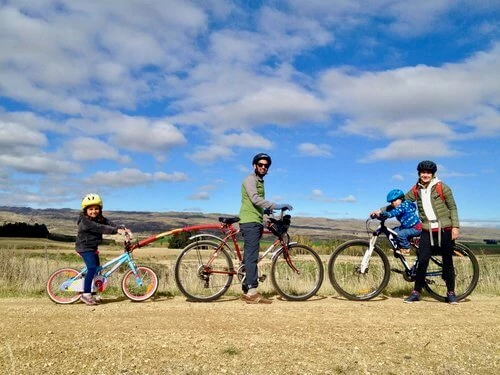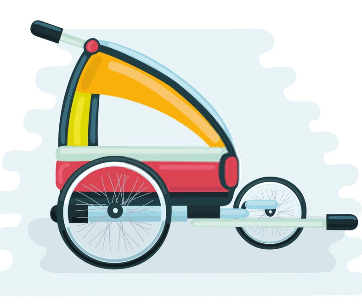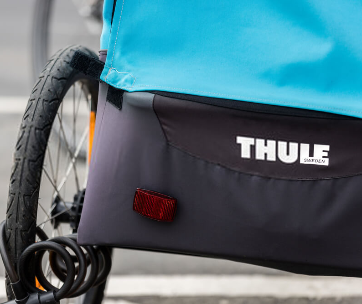Nothing beats the joy of cycling together as a family, especially if there are kids involved. Cycling is not only a pastime activity, but it comes with a whole lot of benefits to children. In a world where people are trapped in different areas of work, creating time to cycle with kids becomes an effective way to bond.
Sometimes bike trailers or bike seats can be effective ways to move around with kids on bikes. However, if your child is too heavy for both, you probably should opt for a tag-a-long or a bike trailer.
What is a tag-a-long bike?
Also known as a trailer bike, trailer cycle, trainer bikes, trailer or trail-a-bike, a tag-a-long bike is an excellent alternative to carry kids who have graduated from child bike seats and bike trailers, and who are ready to pedal by themselves quite often.
Trailer bikes come in different specifications. Sometimes they feature a pedal, while others do not. Mainly, they come in handlebars, a seat for the kid, and a wheel that attaches to the back of the adult bike.
Tag-a-long bikes is just the normal child’s bike, which has the headset, fork, and the front wheel replaced by a long towbar/boom.
The beauty of trailer cycles is that they make kids active passengers rather than passive passengers in bike seats, cargo bikes, and trailers. As the kids pedal, they get to enjoy the safety thanks to the attachment/coupling to the standard adult bike. With the tandem-style solution approach, parents can help build the cycling passion for their kids, bond, build courage, and grow future cyclists.
Trailer cycles are also faster as they ensure that no child is left behind – soon as the kids get tired, they let the parents do the heavy lifting as they get towed. All these thanks to the independent freewheel.
What age is best for a bike trailer?
Trailer cycles are best suited for kids aged four years and above. The kid in question must have the right balance and can confidently use a pedal bike without the stabilizers. As well, the kid must understand that they have to either pedal or maintain their calm as the adult pedals. Still, the child must understand how to mount on the trailer cycle and when to come off the trailer bike.
Factors to Consider before Selecting a Trailer Bike
There are different factors to consider before eventually paying some money for the best trailer cycle. Here are some few things to look at.
1. Categories of Trailer Bikes
There are different trailer bike designs that you probably will come across when shopping for tag-along bikes. Technically, most of the trailer cycles feature one wheel. However, there are those with two wheels, while some have none. By categorization, there are standard, recumbent, and towbar trailer cycles.
Towbar
The towbar trailer cycles do not have any wheel. Instead, they connect the normal kids’ bikes to the adult bike. While attaching the kids’ bike, it might sometimes be imperative to remove the front wheel. The versatility of this option is unimaginable as you can convert a kid’s bike into a trailer cycle and vice versa during a ride. The towbar operates and handles like the normal seat post-mounted tag-along bikes. Another option, albeit rare, is the rear-axle mounted trailer bike that allows you to connect the child’s bike. An example is the Trail-Gator or Two Whee
Standard Tag-a-long Bikes
Also known as kids’ half-bikes, the standard tag-along bikes or trailer cycles attach to the back of an adult bike. They mount to the rear seat post or the rear rack. These types of trailer cycles are suitable for kids from 4-8 years of age. Although they are wobbly, standard trailer cycles reinforce cycling skills for kids.
Characteristically, all the seat post-mounted tag-along bikes attach to the seat post of adult bikes. However, since they articulate on plain bearings, they sometimes have the wobble effect, where they have a unique handling quirk, exhibited through leaning one side when negotiating corners.
On the other hand, the rack-fixing trailer cycles, although rear, feature pivots above the adult bike’s rear axle. An example is the Burley Piccolo.
Recumbent Trailer Cycles
Style-wise, the recumbent trailer cycles feature a chair with pedals that attaches to the rear seat post of the adult bike. Unlike the age we specified earlier, the recumbent trailer cycles can carry kids from 2-9 years. They are suitable for kids who need comfort and stability. Like bike trailers, recumbent trailer cycles feature harness to keep kids secure in one place, lower ground clearance for stability, and seat for comfort. Nevertheless, the specifications come with the issue of weight. When compared to standard trailer cycles, the recumbent trailer cycles are somewhat heavy. An example is the Weehoo Turbo.
2. Compatibility with the Adult Bike
Having rested on the particular category of a trailer cycle to purchase, you have to ensure that it is compatible with the adult bike that will be towing it. As indicated before, most of the trailer cycles attach to the adult bike seat post. As long as you have about 2 inches of the seat post exposed, most of the trailer cycles will automatically connect to the adult bike. Examples of trailer cycles that attach to seat posts are the Wehoo Turbo and the WeeRide Co-Pilot.
Before purchasing, make sure that your seat post has the right circumference. Otherwise, make sure that you choose a hitch on the trailer cycle that will fit your bike. Generally, if the seat post is not round and is made of carbon fiber or other material rather than either steel or aluminum, it is incompatible.
Trailer cycles like the Burley Kazoo and Burley Piccolo attach to the rear rack of the adult bike. Ensure that your bike has a rack eyelet.
3. Attributes of the Child Rider
As you set out to purchase a trailer cycle, the readiness of the child to ride on one matter. Ensure that your child can reach the pedals on the trailer cycle. Most of the trailer bikes have a good reach for children as young as four years.
Apart from reach, also ensure that your child is confident and stable. Recumbent trailer bikes like the Wehoo trailer will have straps, but others don’t. Therefore, ensure that your kid is disciplined enough to maintain their sitting position while on the go. If you have a troublesome yet enterprising kid, consider the Adams Trail-a-Bike backrest that has straps to hold the child in one place. Otherwise, bike trailers and child bike seats can always come in handy for kids who wiggle a lot.
4. Gears
At first, you might argue against gears on a trailer cycle. However, the little contributions the passengers make, eventually count to the efficiency of a ride. When pedaling uphill, your child on the trailer cycle can contribute to the efforts that get both of you up the hill. In this case, adding six or seven-speed gears to the trailer cycle can make a massive difference to a ride, even though the cost increases slightly. Some trailer cycles like the Burley Piccolo have gears and a rear derailleur.
The type of gear shifters also matters a lot. There are two types of gear shifters you will find on tag-a-long bikes: grip shifters and the thumb shifters. The gear shifters help you train your child on gearing.
Our advice is that go for what pleases you. However, note that geared trailer cycles cost a little bit more compared to non-geared trailer cycles. From our experience, the non-geared trailer bikes or the single-speed trailer cycles are also efficient. So, to us, gears do not make so much of a difference to a ride.
Related Reading: Understanding gears on kids' bikes.
5. Safety and Comfort of the Child
Lights – ensure that you have lights attached to the tag-a-long bike and a red reflector or sometimes a flag to comply with traffic laws while at the same time ensuring the safety of your child.
Toe clips – kids have a way of annoying parents when riding, especially if they get tired. In this case, toe clips might help keep their feet on the pedal, ensure a better balance, and increase the kids’ pedaling efficiency. With the toe clips on the kid (s) can freewheel on a trailer cycle with not so much risk of their legs being whacked by the revolving pedals as you pedal. See the Outgeek Pedal Straps, which can do the work on tag-a-long bikes.
Mudguards – when riding in muddy terrains, you must ensure that the adult bike that is towing the trailer cycle has a mudguard. Mudguards protect the kids, even though they have cycling sunglasses on. Besides, the trailer cycle itself might require a mud flap or mudguard.
When cycling in the rain, ensure that the kids have a reflective or visible raincoat, clothing, or lights attached to improve visibility and avoid accidents. As well, ensure that your child has a properly fitting bike helmet.
6. Folding Arm
Trailer cycles come with quick-release connections that are located midway from the arm. The quick-release helps to fold the arm of the trailer bike, which helps improve efficiency when storing or transporting it. It helps ensure the compact storage of the trailer cycle.
7. Mirror
Having a mirror on the adult bike will help you keep an eye on the young one as well as the road behind you. It is an add-on that ensures the safety of your kid, yourself, and other road users. You can have the helmet, gloves, or the bike mirrors, whichever works well for you. It is the same way you would have a mirror to check on your child when on a rear child bike seat.
8. Size of the Trailer Cycle
When buying a trailer bike, consider its size relative to that of the child and the storage space you have. Some of the trailer cycles, such as towbar, are not bulky, which makes them occupy less space. They are also not so cumbersome when hauling most kids. Other trailers like the recumbent bike trailers and the standard trailer cycles might be bulky and will take much space. If the latter is your choice, you should plan your space with an entire additional bike in mind as they take nearly the same space as an entire bike.
9. Tires
When selecting a trailer cycle, ensure that the tires are either slick or semi-slick. Avoid the knobby tires at all costs unless your tag-along bike is exclusive to be used in off-road cycles. Tires without treads make it easier to ride the trailer cycle. However, for off-road adventures, go for the tires with good treads.
A word of caution on Brakes for Trailer Cycles
Brakes are not essential in trailer cycles. They are very dangerous when activated at the wrong time. For instance, a stubborn kid might activate the brakes when you are pedaling, which might make the trailer cycle skid.
Therefore, if the towing bike’s brakes are good, there is no need to bother attaching brake systems to the trail-a-bike.
From our experience, when you attach the trailer cycle to the back of a heavy bike – such as when you have a pannier on the towing bike, ensure that you have a drag brake on it so that you can control the speed, especially for the long descents.
Preparing Kids for tag-a-long Bike Rides
Moving around with kids on bikes is fun. For those of you who have tried bike seats and bike trailers, you just got the fun started. The joy resides with the tag-a-long bikes. Now, as you set out to ride with your kid on a trailer cycle, it is vital that you help them understand the basics.
First off, make sure that your passenger/co-rider understands the parts of the trailer cycle. In most cases, they can always help point out some hitches with the tag-a-long bike while you are on the move.
Secondly, ensure that the child understands how to maintain their sitting position to avoid resistance. Also, instruct the child to avoid the side-to-side lurching while pedaling, which eventually affects the efficiency of your pedaling.
Third, help the passenger understand that their contribution –even the little of it, is appreciated during the ride. Doing so, boosts their morale. Even though kids do not pedal as much, their contribution, especially when ascending uphill, eventually counts.
Always talk to your child as you enjoy the ride. Teach them bike stuff and get to bond to avoid boredom. For instance, when you need help when ascending, have a power word to use like “time for the deserved boost!”
As you cycle, assess the levels of energy and commitment of your passenger. Mostly, when riding, kids like to stop to have water or snacks, learn to understand when the time is ripe for the same.
With your mirrors on, cheer your little rider and ensure they never fall asleep while on the go. With all these in place, we at KiddingZone can comfortably wish you a pleasant ride!
Questions to ask yourself as you purchase a trailer Cycle
- What is the age of your child?
- Does the child fit into the trailer, child bike seat, or trailer cycle bracket?
- What type of trailer do you want?
- Where will you mostly cycle?
- What is the weight of the child?
- Does the child need strapping?
- What is your budget?
- Do you have enough storage for your trailer cycle?
- What brand of a trailer cycle are you looking for?
Parting Shot!
With the questions in mind, our guide on how to choose trailer bikes, and your budget, you can now check out our review of the best trailer cycles and make up your mind. There are many discussions surrounding bike seats, trailers, and trailer cycles. However, whichever choice you make, it is your happiness and that of the child that matters as long as comfort and safety are not sacrificed. As you decide what trailer is best for you, we encourage that you ask questions, share your experiences, and let us know new products or ideas to incorporate. Our dream is to make it easy for families to cycle together.





Comments